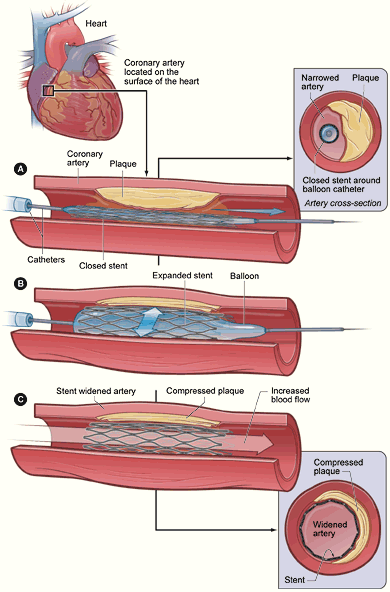
“Optimal Medical Therapy with or without PCI for Stable Coronary Disease”
by the Clinical Outcomes Utilizing Revascularization and Aggressive Drug Evaluation (COURAGE) Trial Research Group
N Engl J Med. 2007 Apr 12;356(15):1503-16 [free full text]
—
The optimal medical management of stable coronary artery disease has been well-described. However, prior to the 2007 COURAGE trial, the role of percutaneous coronary intervention (PCI) in the initial management of stable coronary artery disease was unclear. It was known that PCI improved angina symptoms and short-term exercise performance in stable disease, but its mortality benefit and reduction of future myocardial infarction and ACS were unknown.
The trial recruited patients with stable coronary artery disease. (See paper for inclusion/exclusion criteria. Disease had to be sufficiently and objectively severe, but not too severe, and symptoms could not be sustained at the highest CCS grade.) Patients were randomized to either optimal medical management (including antiplatelet, anti-anginal, ACEi/ARB, and cholesterol-lowering therapy) and PCI or to optimal medical management alone. The primary outcome was a composite of all-cause mortality and non-fatal MI.
2287 patients were randomized. Both groups had similar baseline characteristics with the exception of a higher prevalence of proximal LAD disease in the medical-therapy group. Median duration of follow-up was 4.6 years in both groups. Death or non-fatal MI occurred in 18.4% of the PCI group and in 17.8% of the medical-therapy group (p = 0.62). Death, non-fatal MI, or stroke occurred in 20.0% of the PCI group and 19.5% of the medical-therapy group (p = 0.62). Hospitalization for ACS occurred in 12.4% of the PCI group and 11.8% of the medical-therapy group (p = 0.56). Revascularization during follow-up was performed in 21.1% of the PCI group but in 32.6% of the medical-therapy group (HR 0.60, 95% CI 0.51–0.71, p < 0.001). Finally, 66% of PCI patients were free of angina at 1 year follow-up compared with 58% of medical-therapy patients (p < 0.001); rates were 72% and 67% at 3 years (p=0.02) and 72% and 74% at five years (not significant).
Thus, in the initial management of stable coronary artery disease, PCI in addition to optimal medical management provided no mortality benefit over optimal medical management alone. However, initial management with PCI did provide a time-limited improvement in angina symptoms.
As the authors of COURAGE nicely summarize on page 1512, the atherosclerotic plaques of ACS and stable CAD are different. Vulnerable, ACS-prone plaques have thin caps and spread outward along the wall of the coronary artery, as opposed to the plaques of stable CAD which have thick fibrous caps and are associated with inward-directed remodeling that narrows the artery lumen (and thus cause reliable angina symptoms and luminal narrowing on coronary angiography).
Notable limitations of this study: 1) the population was largely male, white, and 42% came from VA hospitals, thus limiting generalizability of the study; 2) drug-eluting stents were not clinically available until the last 6 months of the study, so most stents placed were bare metal.
Later meta-analyses were weakly suggestive of an association of PCI with improved all-cause mortality. It is thought that there may be a subset of patients with stable CAD who achieve a mortality benefit from PCI.
The 2017 ORBITA trial made headlines and engendered sustained controversy when it demonstrated in a randomized trial that, in the context of optimal medical therapy, PCI did not increase exercise time more than did a sham-PCI. Take note of the relatively savage author’s reply to commentary regarding the trial. See blog discussion here. The ORBITA-2 trial is currently underway.
Last month, the ISCHEMIA trial was published in NEJM. It demonstrated that among patients with stable CAD and moderate to severe ischemia, an initial invasive strategy did not reduce the risk of ischemic cardiovascular events or death from any cause at a median of 3.2 years follow-up.
It is important to note that all of the above discussions assume that the patient does not have specific coronary artery anatomy in which initial CABG would provide a mortality benefit (e.g. left main disease, multi-vessel disease with decreased LVEF). Finally, PCI should be considered in patients whose physical activity is limited by angina symptoms despite optimal medical therapy.
Further Reading:
1. COURAGE @ Wiki Journal Club
2. COURAGE @ 2 Minute Medicine
3. Canadian Cardiovascular Society grading of angina pectoris
4. ORBITA-2 @ ClinicalTrials.gov
5. ISCHEMIA @ ClinicalTrials.gov
6. Discussion re: ISCHEMIA trial changes @ CardioBrief
7. ISCHEMIA full text @ NEJM
Summary by Duncan F. Moore, MD
Image Credit: National Institutes of Health, US Public Domain, via Wikimedia Commons